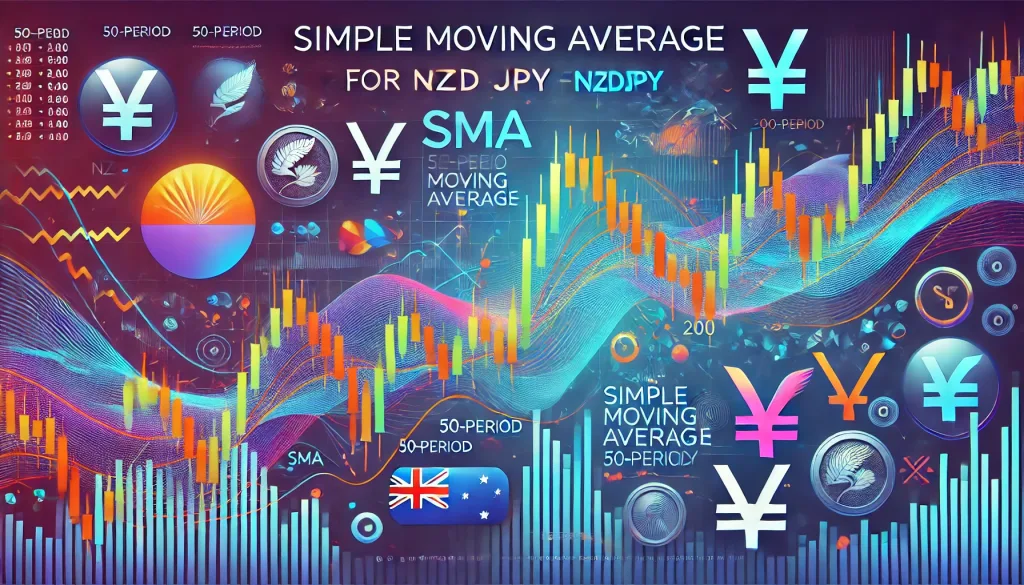Simple Moving Average Mastery for NZDJPY: Hidden Secrets Revealed

The Simple Moving Average Secret for NZDJPY Traders
Trading the NZDJPY pair can sometimes feel like trying to herd cats—unpredictable, chaotic, and downright frustrating. But here’s the good news: one of the most overlooked tools in Forex trading, the Simple Moving Average (SMA), can be your secret weapon. Today, we’re uncovering how to use the SMA to outsmart the market, avoid common pitfalls, and identify golden opportunities in the NZDJPY pair.
Why Simple Moving Averages Are a Trader’s Best Friend
Imagine SMA as the seasoned coach of your favorite sports team. While other indicators scream for attention with flashy moves, SMA quietly observes, giving you a consistent and reliable game plan. By averaging past price data, SMA smooths out market noise, helping you focus on the bigger picture.
For NZDJPY, a currency pair influenced by economic trends, market sentiment, and commodity prices, the SMA provides clarity amidst the chaos. It’s not just an indicator—it’s your trading compass.
Key Tip: Use a 50-period SMA for medium-term trends and a 200-period SMA for long-term trends. These are like your trading binoculars, offering a clear view of where the market’s headed.
The Hidden Patterns in NZDJPY: Using SMA to Your Advantage
Have you ever noticed how NZDJPY loves to bounce off its 200-period SMA like a rubber ball? This isn’t magic; it’s market psychology at work. Traders worldwide monitor these levels, creating self-fulfilling prophecies.
Actionable Insight:
- Support and Resistance: When the price approaches the 200-period SMA, watch for reversals. If the price bounces upward, it’s a strong buy signal; if it breaks below, prepare to sell.
- Crossovers: The golden crossover (when the 50-period SMA crosses above the 200-period SMA) screams bullish momentum. The death cross (when the 50-period SMA crosses below the 200-period SMA) signals bearish trends. Trust these signals but verify with volume and other indicators.
Avoiding Common SMA Mistakes (Because No One Likes a Rookie Move)
Let’s face it: relying solely on SMA is like going to a potluck with just a bag of chips. Don’t be that trader. Combine SMA with other tools like RSI or MACD for a full-course strategy.
Common Pitfall: Blindly following SMA crossovers without context. Always analyze the broader market conditions.
Pro Tip: During ranging markets, SMA might give false signals. Switch to shorter periods or use exponential moving averages (EMA) for faster responsiveness.
Trading NZDJPY Like a Pro: Underground Tips
- Trend Strength Assessment: Use the distance between the price and SMA to gauge trend strength. Wider gaps indicate stronger trends.
- Dynamic Stop-Loss Placement: Place your stop-loss levels just below the SMA in uptrends and above the SMA in downtrends. It’s like giving your trade a safety net.
- Pairing SMA with Fundamentals: Keep an eye on New Zealand’s dairy prices and Japan’s economic data. These fundamentals often align with SMA signals for NZDJPY.
When SMA Becomes the Unexpected Hero
Picture this: You’ve entered an NZDJPY trade, and it’s going great. Then, out of nowhere, the market reverses. Panic sets in. This is where SMA’s calm, collected approach saves the day. By sticking to your SMA signals, you avoid impulsive decisions and stay on course.
Real-Life Example: In September 2023, NZDJPY bounced off the 200-period SMA after hitting a multi-month low. Traders who followed this signal reaped significant profits as the pair rallied over 150 pips within days. Lesson? Trust the process.
The SMA isn’t flashy, but it’s reliable, consistent, and—when paired with the right strategy—exceptionally powerful. For NZDJPY traders, it’s a tool that uncovers hidden opportunities, mitigates risks, and simplifies decision-making.
So, the next time you feel lost in the Forex wilderness, remember: the SMA is your guiding star. Whether you’re aiming for steady profits or trying to recover from a bad trade, this humble indicator has your back.
Quick Recap:
- Use 50-period and 200-period SMAs for trend analysis.
- Watch for support/resistance at SMA levels and crossovers.
- Combine SMA with fundamentals and other indicators for robust strategies.
- Avoid relying solely on SMA during ranging markets.
Ready to take your NZDJPY trading to the next level? Dive deeper into advanced methodologies and elite tactics with our free resources at StarseedFX.com.
—————–
Image Credits: Cover image at the top is AI-generated
PLEASE NOTE: This is not trading advice. It is educational content. Markets are influenced by numerous factors, and their reactions can vary each time.

Anne Durrell & Mo
About the Author
Anne Durrell (aka Anne Abouzeid), a former teacher, has a unique talent for transforming complex Forex concepts into something easy, accessible, and even fun. With a blend of humor and in-depth market insight, Anne makes learning about Forex both enlightening and entertaining. She began her trading journey alongside her husband, Mohamed Abouzeid, and they have now been trading full-time for over 12 years.
Anne loves writing and sharing her expertise. For those new to trading, she provides a variety of free forex courses on StarseedFX. If you enjoy the content and want to support her work, consider joining The StarseedFX Community, where you will get daily market insights and trading alerts.
Share This Articles
Recent Articles
The GBP/NZD Magic Trick: How Genetic Algorithms Can Transform Your Forex Strategy
The British Pound-New Zealand Dollar: Genetic Algorithms and the Hidden Forces Shaping Currency Pairs
Chande Momentum Oscillator Hack for AUD/JPY
The Forgotten Momentum Trick That’s Quietly Dominating AUD/JPY Why Most Traders Miss the Signal
Bearish Market Hack HFT Firms Hope You’ll Never Learn
The One Bearish Market Hack High Frequency Traders Don't Want You to Know The

